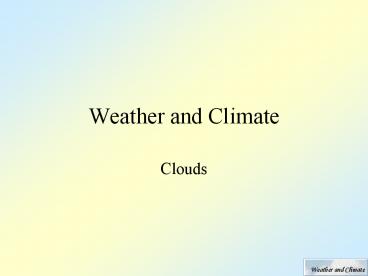Weather and Climate - PowerPoint PPT Presentation
1 / 47
Title: Weather and Climate
1
Weather and Climate
- Clouds
2
Dew and Frost
- Where does dew and frost form? Why?
3
Frozen Dew vs. Frost
- Are frozen dew and frost the same thing?
- Frozen dew forms when the air temperature gets
below freezing after dew forms. - Frost occurs when the dew point temperature is at
or below freezing. - Water vapor goes directly from vapor to solid.
4
When the dew is on the grass,rain will never
come to pass.When grass is dry at morning
light,look for rain before the night!
5
Good Conditions for Dew Formation
- Clear, calm nights ? good for dew
- Cloudy, windy night ? dew not likely
- Calm clear nights are usually associated with a
high pressure fair weather system. - Cloudy and windy weather is usually associated
with an approaching storm system.
6
What is black frost?
- Sometimes the air temperature may go below
freezing but no frost forms. - The air is very dry
- The dew point temperature is never reached.
- This is also called simply a freeze.
- This type of event is very damaging to crops.
7
Clouds Condensation Nuclei
- Sources
- Dust
- Volcanoes
- Factory smoke
- Forest fires
- Salt from ocean spray
- Sulfate particles emitted by phytoplankton
8
Hygroscopic vs. Hydrophobic
- Some particulates attract water and are called
hygroscopic. - Such as ocean salt, sulfuric acid, nitric acid
- Water can condense in less than 100 relative
humidity. - Some particulates repel water and are called
hydrophobic. - Such as oils, gasoline, paraffin waxes, Teflon
- Water vapor will resist condensing even when
relative humidity is greater than 100. - At any given time there are usually enough
condensation nuclei for clouds to form near 100
relative humidity.
9
Haze
10
Fog
- Fog is not the same as haze, but can often
develop from haze. - Fog has a visibility less than 1km (0.62miles).
- There are different mechanisms for fog formation.
11
Radiation Fog
12
Valley Fog
- Valley fog is a type of radiation fog.
- Cold, heavy air drains down mountains and
collects in the valleys. - Rivers running through valleys, helps make them
very susceptible to fog.
13
Advection Fog
14
Upslope Fog
15
Evaporation (Mixing)Fog
- This fog is formed by the same process that
allows you to see your breath on a cold winter
day. - This fog is formed by two unsaturated parcels of
air mixing.
16
Steam Fog
17
Frontal Fog
- Type of evaporation (mixing) fog.
- Warm rain falling through a layer of cold moist
air can produce fog. - This is commonly observed before a warm front, or
behind a cold front, hence the name - Also called precipitation fog.
18
Foggy Weather
- The three regions of the US with the most number
of heavy fog days are - The Pacific Coast States
- The Appalachian highland region
- New England
19
Is fog good or bad?
20
Cloud Types
1.
2.
3.
4.
21
Howards System
- Wispy clouds were named cirrus, which means
curl of hair in Latin. - Puffy clouds were named cumulus, which means
heap in Latin. - Sheet like clouds were named stratus which
means layer in Latin. - Rain clouds were named nimbus, which means
violent rain in Latin. - By combining these basic types different clouds
could be described.
22
Combining Names
- Cumulonimbus ?
- Nimbostratus ?
- Stratocumulus ?
- Rain and puffylook
- Rain and layer look
- Layer and puffy look
23
Cloud Types
- In 1887, Abercromby and Hildebrandsson expanded
Howards classification. - Clouds were divided into four groups
- High clouds
- Middle clouds
- Low clouds
- Clouds with vertical development
24
High Clouds (Cirrus)
- In the middle and low latitudes, high clouds
generally form above 20, 000ft. - These clouds are mostly ice crystals and are very
thin. Why?. - Higher up it is cold! Cold air has less of a
capacity for water vapor. - These clouds appear white in color.
25
High Clouds
26
Cirrocumulus
27
Cirrostratus
28
Cirrostratus
29
Cirrostratus
30
Middle Clouds (Alto)
- Cloud base begins 6,500ft-23,000ft, in middle
latitudes. - Composed of water droplets, except when cold
enough for ice crystals.
31
Altocumulus
32
Altostratus
- Often cover the entire sky, extending over
hundreds of square kilometers. - Sometimes the sun can be seen through these
blue-gray clouds, appearing as a watery sun.
33
(No Transcript)
34
Low clouds
- Base of clouds is below 2000m (6,500 ft.)
- Almost always composed entirely of water
droplets. - In extremely cold weather may contain ice
particles and snow.
35
Nimbostratus
36
Stratocumulus
37
Stratus
38
Cumulus
Clouds with Vertical Development
Cumulus Congestus
39
Cumulus Humilis
- Cumulus Congestus
40
Cumulonimbus
- These are thunderstorm clouds.
- These clouds may extend from 600m into the
tropopause. - Often characterized by an anvil top.
- Produce lightning, hail, and thunder.
41
(No Transcript)
42
Lenticular Clouds
43
Pileus
44
Mammatus Clouds
- For formation Sinking air must be colder than
surrounding air and have a high liquid water or
ice content. - The sinking air warms, but not very quickly
because of the latent heat taken from the air to
evaporate the liquid, or melt the ice. - If the sinking air remains saturated and cooler
than the surrounding air, the sinking occurs
beyond the base of the cloud.
45
Mammatus Clouds
46
Nacreous Clouds
47
Noctilucent Clouds































